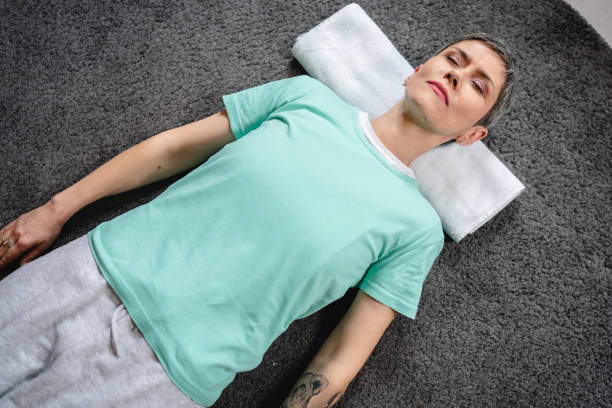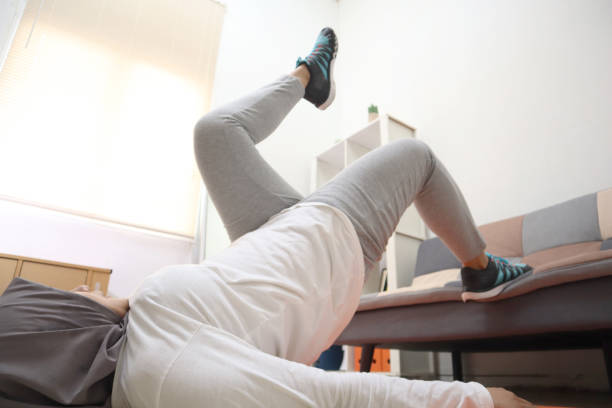Introduction

If you often wake up with uncomfortable aches and pains that disturb your sleep, we have a solution for you. Check out our blog post "Stretching and Exercises for a Pain-free Sleep" for valuable insights. We empathize with your struggle to get a good night's sleep and would like to offer assistance.
This article delves into the advantages of integrating stretching and targeted exercises into your bedtime routine. Say farewell to discomfort and welcome a serene, pain-free slumber that will refresh you and prepare you to conquer the day. Explore various stretches and exercises aimed at enhancing your sleep quality. These practices have the potential to revamp your experience during the night.
What stretches help sleep?
Stretching is an excellent way to prepare for a good night's sleep. Adding simple stretches to your bedtime routine can reduce physical tension and promote mental relaxation. Ideal stretches include neck rolls, spinal twists, hamstring stretches, and shoulder shrugs (try 30 seconds of each). These gentle exercises help relax tight muscles and improve posture, allowing for a more comfortable sleep.
Understanding the Benefits of Stretching

Stretching exercises can help you get a better night's sleep. Stretching boosts blood flow to your muscles, relaxing them and making them more flexible. Flexible muscles are less prone to aches and pains that disrupt sleep, allowing us to rest more fully and deeply. Regular stretching also helps reduce stress, improve posture, and reduce the risk of injury.
You can do various stretching exercises to enhance your sleep quality. Before starting physical activity, it is recommended to use dynamic stretching, which involves active movements and has beneficial effects. In contrast, static stretching involves holding a position for a prolonged period to improve flexibility. You may also opt for foam rolling or massage therapy to focus on specific body areas.
Tips for Stretching Before Bed
Consider incorporating stretching into your bedtime routine to help reduce muscle tension and promote better sleep at night. I can offer tips to help you get the most out of your stretching routine.
-
Start with dynamic stretches such as shoulder rolls, arm swings, and neck circles.
-
Take deep breaths while stretching to help your muscles relax.
-
Do static stretches in the evening for 10-15 minutes before bed.
-
Stretch at least twice daily—ideally once in the morning and once at night.
-
Listen to your body's signals — Stop and adjust your position if a stretch causes pain.
-
If you have long-lasting muscle pain that's disrupting your sleep, it's recommended that you consult a doctor or physical therapist for advice.
Stretching daily can improve your sleep quality and reduce the likelihood of getting injured. Relieving tension in the body promotes a good night's sleep. By spending a few minutes stretching before bedtime, you can enhance your sleep comfort and wake up feeling rejuvenated.
Other Tips for a Pain-free Sleep

To complement your exercise routine, make sure to adopt good sleep habits. This includes maintaining a consistent sleep schedule, refraining from consuming caffeine late in the day, minimizing screen time before sleep, and creating a comfortable, quiet sleeping environment.
Considering all these elements for a good night's sleep is important. Furthermore, practicing relaxation techniques like deep breathing or progressive muscle relaxation can assist in decreasing stress and tension before going to bed, contributing to a better quality of sleep. It's important to consider these essential factors to achieve better sleep quality. You can also try practicing relaxation techniques like deep breathing or progressive muscle relaxation to alleviate stress and tension before going to bed. This can further enhance the quality of your sleep.
Finally, talking to your healthcare provider is important for relieving chronic pain and sleeping well. Your healthcare provider can recommend treatment options and lifestyle modifications to help you find more restful sleep.
To achieve a restful night's sleep and remain pain-free during the day, you can incorporate stretching, exercise, healthy sleep patterns, relaxation techniques, and advice from your healthcare provider.
How can I sleep better without pain?
Getting a good night's sleep is important for both your physical and mental health. However, if you're experiencing pain, it can make it difficult to sleep well. To improve your sleep quality and reduce discomfort, knowing the different steps you can take is important.
First, make sure to establish regular bedtimes and wake times. This will help set your body's internal clock to prepare it for sleep. If you have difficulty sleeping, try avoiding caffeine and alcohol before bed. Both can disrupt your sleep cycle and cause painful awakenings.
Second, ensure that your mattress and pillow are comfortable for you. Even if they appear in good condition, these items can become uncomfortable with age. Investing in a new mattress and pillow may benefit your sleep quality.
Third, try to create a restful environment in the bedroom by ensuring it is dark, quiet, and temperature-controlled. Keeping distracting electronics out of the room can also help promote better sleep. Try relaxation methods such as deep breathing or meditation before bedtime to improve your sleep. These techniques can calm both your body and mind.
Finally, consult a healthcare professional to discuss treatment options if you experience chronic pain or severe difficulty sleeping. Various medications and treatments can aid in decreasing your pain and enhancing the quality of your sleep.
Improving your sleep and reducing pain can be achieved by following these guidelines. Remember, getting a good night's rest is crucial to living a healthy and happy life.
What is the best exercise for better sleep?

Best exercise practices are important to maintain optimal health. To stay healthy, it's important to exercise regularly. Eating healthily and being physically active can benefit your heart, weight, energy, and mental health. According to health experts, adults should aim to engage in at least 150 minutes of moderate-intensity aerobic exercise per week to maintain good health.
This can include activities like walking, swimming, cycling, and jogging. Strength training also benefits muscle strength, bone health, and weight control. According to recommendations, it is suggested that strength training is done at least two days per week.
Staying active doesn't have to be boring or time-consuming. To incorporate exercise into your daily routine, try using stairs instead of elevators, commuting or walking to the store, and participating in sports with your loved ones. It's also essential to keep things varied by trying different activities, joining a sports team, or attending fitness classes at your nearby gym.
Remember to start at a manageable pace and consider how much exercise you can realistically incorporate into your routine. It's important to warm up before any activity and cool down afterward with light stretching exercises. Beginners must prioritize exercise.
It is crucial to prioritize safety during physical activity. Thus, before beginning a new exercise routine, always consult your healthcare provider and take adequate precautions. Remember that even small fitness improvements can bring long-term health benefits. With dedication and commitment, you'll be on your way to a healthier lifestyle.
How can I relax my body to sleep?
Relaxation begins with stretching and exercises that target your body's tight spots. Focus on the neck, shoulder, and back muscles to relieve tension and improve posture. Gentle stretching can help reduce muscle strain, leading to a more comfortable sleep.
To ease into a relaxing position for the night, try this simple exercise: Slowly turn your head from left to right and position your arms behind your head with your elbows extended outward. This simple motion will stretch your neck and shoulder muscles to reduce tension.
If you struggle with lower back pain, try using a foam roller or yoga ball while laying on your back. This allows for gentle massage of the affected area and improved circulation, which can help reduce pain.
These exercises can improve flexibility and circulation, leading to more restful sleep. To enhance the quality of your sleep and wake up feeling rejuvenated, develop a personalized routine and ensure that you adhere to it consistently, even as it becomes more effortless over time. Remember to add regular stretching to your routine, as it can help your muscles relax and improve your sleep quality.
Foam wedges can help provide extra support and maintain an optimal position for pain-free sleep. These wedges help relieve pressure and support your body as your muscles relax while you sleep. Regular stretching and the right tools can create a mattress-friendly sleeping environment to improve sleep quality.
FAQ's
How to fall asleep quickly?
To fall asleep quicker, here are a few things you can do:
1. To improve your sleep, try to stick to a regular sleep routine by going to bed and waking up around the same time every day.
2. Avoid stimulants like caffeine, nicotine, and alcohol before bedtime
3. Create a relaxing evening routine – take a warm shower or bath, read a book, or listen to soothing music
4. Avoid screens and digital devices at least an hour before bed
5. Exercise regularly but finish your workouts at least three hours before bedtime
Does stretching help with sleep?
Stretching can help you relax and unwind before bed, improving your posture and muscle strength. Stretching helps to relieve body tension, leading to a better night's sleep. Regular stretching also increases circulation and flexibility, helping to reduce pain and discomfort that might otherwise keep you up at night. Try incorporating a few stretches into your evening routine to take advantage of these benefits and help you sleep better.
What are the best stretching exercises for pain-free sleep?
The best stretching exercises for pain-free sleep target the neck, shoulders, and back muscles and lower back stretches. First, place your hands behind your head and ensure your elbows are wide apart. Then, gently turn your head from one side to the other. This will help stretch your neck and shoulder muscles to reduce tension. For lower back pain, try using a foam roller or yoga ball while laying on your back – this allows for gentle massage of the affected area and improved circulation, leading to a better night's sleep.
How can I stretch without pain?
It's important to never experience pain while stretching. If you feel any discomfort, it's best to stop immediately and seek advice from a doctor or physical therapist on stretching safely and effectively. To ensure safety, it's recommended to begin with slow and gentle stretches until your muscles are warmed up.
What is natural stretching?
Natural stretching is a form of exercise that involves gently lengthening and relaxing the muscles in your body. This type of stretching helps to improve flexibility, range of motion, and circulation while relieving tension in the body. It also helps reduce physical stress, leading to improved overall sleep quality.
Conclusion
The article has helped you comprehend why stretching is crucial for obtaining good and painless sleep. Regular exercise combined with targeted stretching can help reduce muscle tension and improve your posture, leading to a more comfortable sleep experience. It is crucial to start your exercise routine slowly and determine a realistic amount of time you can commit to it. To reap the benefits of stretching and enhance your sleep, it is recommended that you develop a customized routine that suits your requirements.

